Influence of mastitis and repeat breeding incidence on participation in the animal insurance program for dairy farmers in Ba Vi, Hanoi, Vietnam
The livestock insurance program for dairy farmers in Vietnam
targeting various acute diseases began in 2011 as a pilot project;
however, due to vaccination campaigns, outbreaks of such diseases
are rare. The objective of this study was to investigate the effects of
mastitis and reproductive failure-which chronically affect the
farming economy-on the decision to participate in the insurance
program. A survey involving a questionnaire and milk sampling from
apparently healthy animals was conducted on the 38 participating and
59 non-participating dairy farms in the livestock insurance program
in Ba Vi, Hanoi, Vietnam, in August 2014. Microbiological tests
were performed to detect sub-clinical mastitis, whereas the
questionnaire was administered to collect information regarding farm
management and the occurrence of clinical mastitis and reproductive
failure over the previous three months. There were no significant
differences in the proportion of farms having cows with clinical
mastitis (insured: 8/38 farms, 21.1% vs. non-insured: 13/58 farms,
NA = 1, 22.8%, p = 1) and repeat breeders (insured: 16/36 farms, NA
= 2, 44.4% vs. non-insured: 20/57 farms, NA = 2, 35.1%, p = 0.49)
over the previous three months. The proportion of farms having cows
with sub-clinical mastitis at the time of the survey was also not
significantly different between insured (5/38 farms, 13.2%) and noninsured (7/59 farms, 11.91%) farms (p = 1). Based on the obtained
results, neither endemic disease nor farm management is respectably
involved in the decision of farms to participate in the animal
insurance program targeting acute animal infectious diseases.
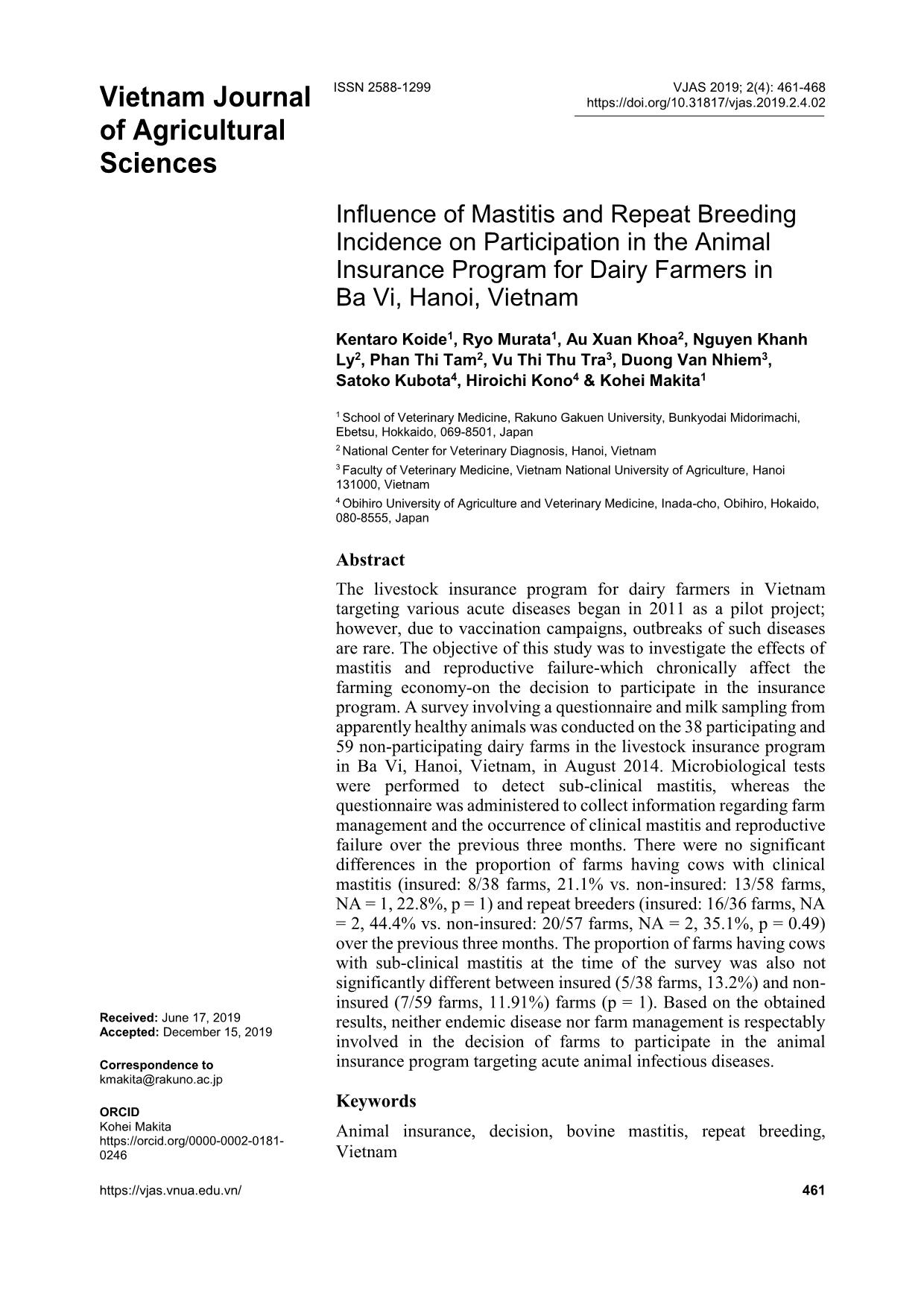
Trang 1
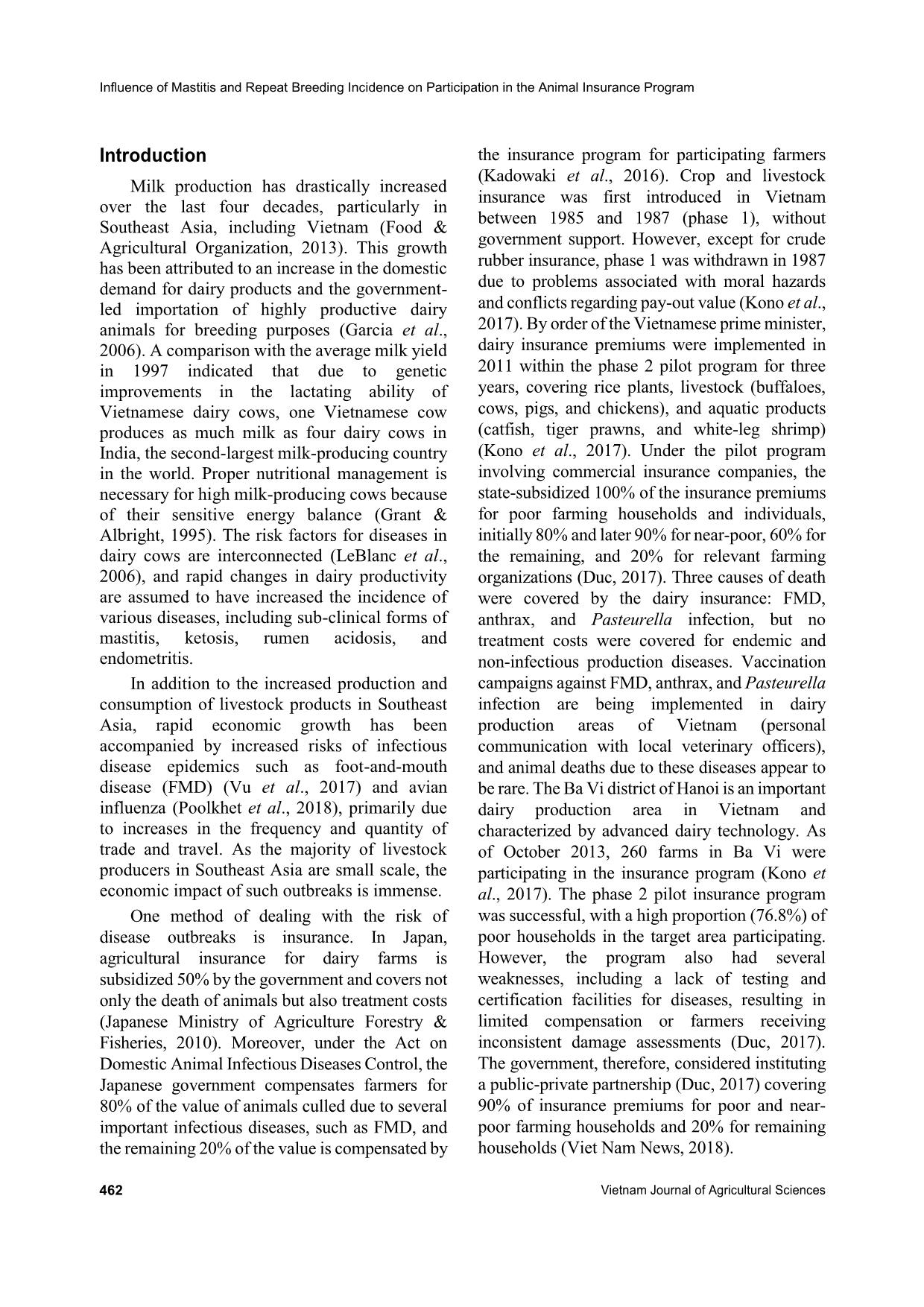
Trang 2
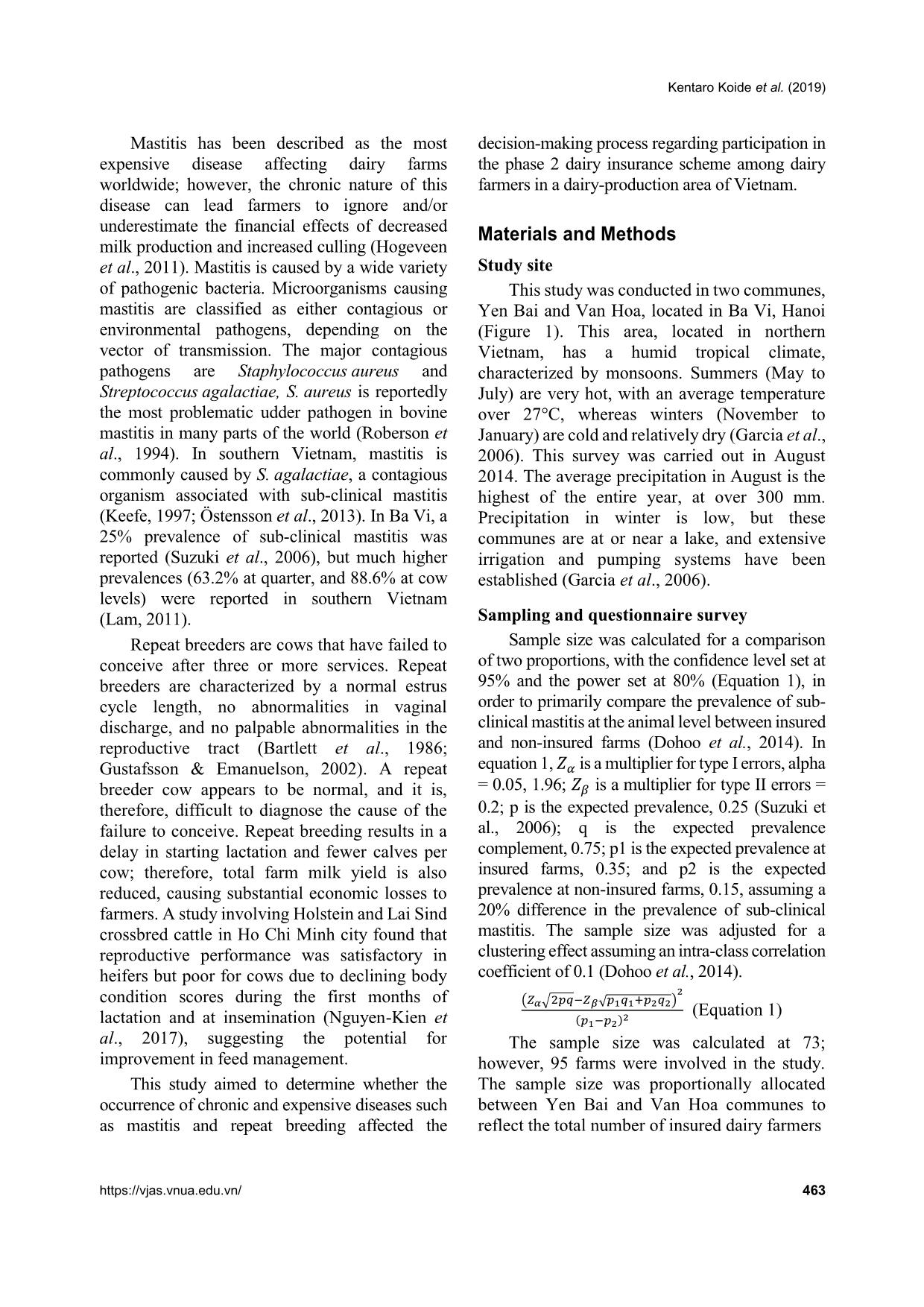
Trang 3

Trang 4
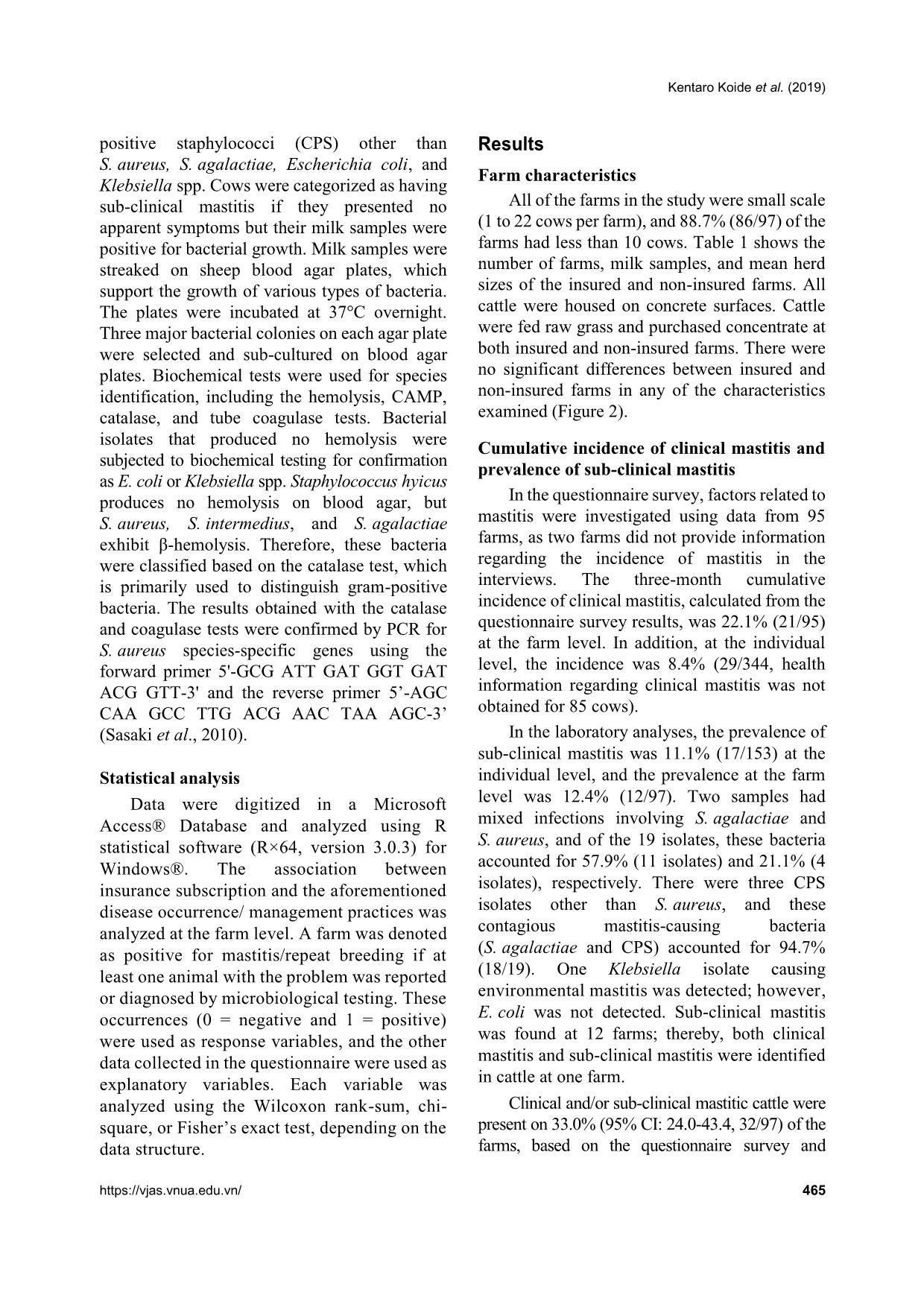
Trang 5

Trang 6
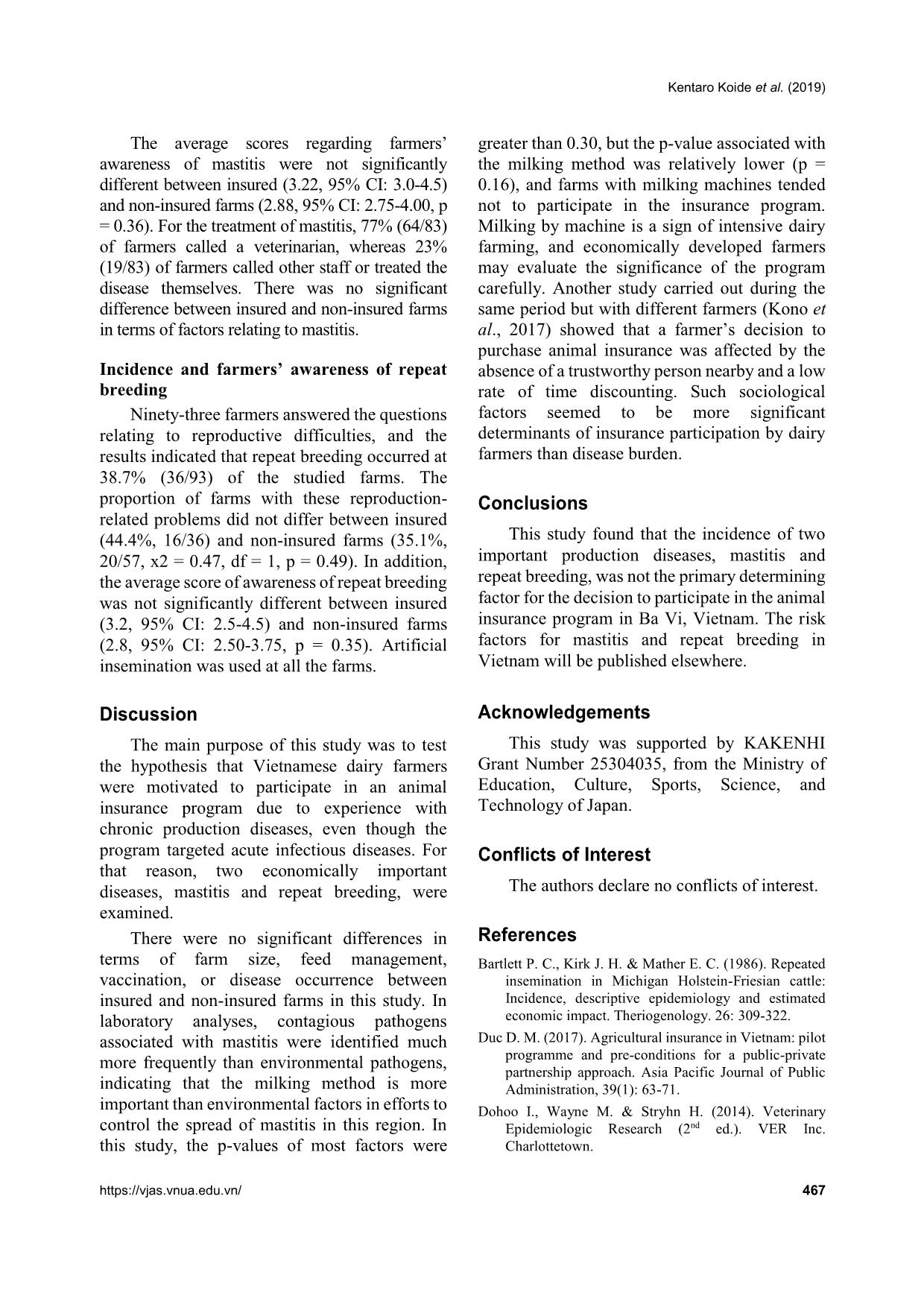
Trang 7
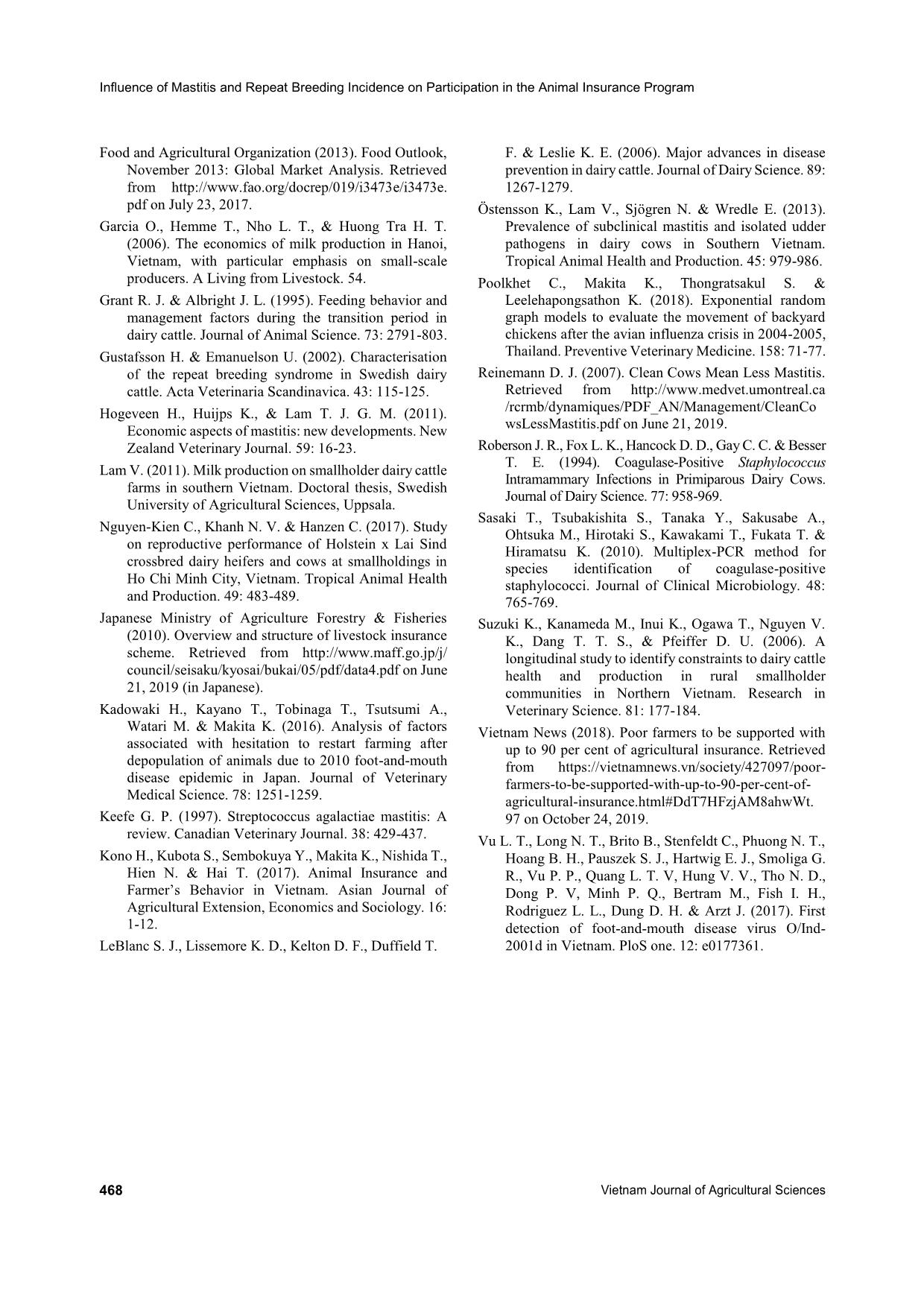
Trang 8
Tóm tắt nội dung tài liệu: Influence of mastitis and repeat breeding incidence on participation in the animal insurance program for dairy farmers in Ba Vi, Hanoi, Vietnam
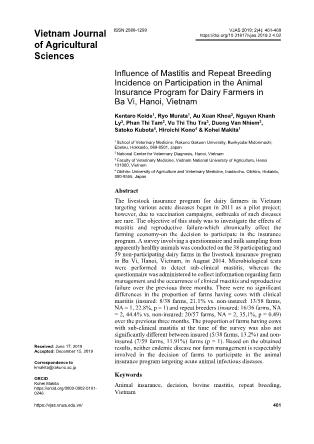
nistered to obtain information regarding dairy management and hygiene awareness as well as cattle health outcomes. Occurrences of mastitis and repeat breeding within the previous three months were queried for each individual cow. The degree of each farm’s sanitation was graded on a scale of 1-4 (1: cleanest to 4: dirtiest) for three parts of each cow: legs, udder, and flank and upper leg (Reinemann, 2007). The average score of the three parts for all cattle was recorded as the farm’s hygiene score. Farmers were also asked to rate their level of awareness regarding diseases common in cows, including mastitis and repeat breeding, using a Likert scale, with 0 indicating no problem and 5 indicating a significant problem. Informed consent was obtained from all the farmers participating in this study at the time the interview was performed. This study did not involve invasive treatments in animals or collection of personal information through interviews. All interviewing and sampling procedures adopted in this study were approved by the ethics committee of Rakuno Gakuen University, Japan (approval number: 16-8). Laboratory examinations Causal organisms of sub-clinical mastitis were isolated from the collected milk samples. Microbial species isolated included coagulase- Kentaro Koide et al. (2019) https://vjas.vnua.edu.vn/ 465 positive staphylococci (CPS) other than S. aureus, S. agalactiae, Escherichia coli, and Klebsiella spp. Cows were categorized as having sub-clinical mastitis if they presented no apparent symptoms but their milk samples were positive for bacterial growth. Milk samples were streaked on sheep blood agar plates, which support the growth of various types of bacteria. The plates were incubated at 37°C overnight. Three major bacterial colonies on each agar plate were selected and sub-cultured on blood agar plates. Biochemical tests were used for species identification, including the hemolysis, CAMP, catalase, and tube coagulase tests. Bacterial isolates that produced no hemolysis were subjected to biochemical testing for confirmation as E. coli or Klebsiella spp. Staphylococcus hyicus produces no hemolysis on blood agar, but S. aureus, S. intermedius, and S. agalactiae exhibit β-hemolysis. Therefore, these bacteria were classified based on the catalase test, which is primarily used to distinguish gram-positive bacteria. The results obtained with the catalase and coagulase tests were confirmed by PCR for S. aureus species-specific genes using the forward primer 5'-GCG ATT GAT GGT GAT ACG GTT-3' and the reverse primer 5’-AGC CAA GCC TTG ACG AAC TAA AGC-3’ (Sasaki et al., 2010). Statistical analysis Data were digitized in a Microsoft Access® Database and analyzed using R statistical software (R×64, version 3.0.3) for Windows®. The association between insurance subscription and the aforementioned disease occurrence/ management practices was analyzed at the farm level. A farm was denoted as positive for mastitis/repeat breeding if at least one animal with the problem was reported or diagnosed by microbiological testing. These occurrences (0 = negative and 1 = positive) were used as response variables, and the other data collected in the questionnaire were used as explanatory variables. Each variable was analyzed using the Wilcoxon rank-sum, chi- square, or Fisher’s exact test, depending on the data structure. Results Farm characteristics All of the farms in the study were small scale (1 to 22 cows per farm), and 88.7% (86/97) of the farms had less than 10 cows. Table 1 shows the number of farms, milk samples, and mean herd sizes of the insured and non-insured farms. All cattle were housed on concrete surfaces. Cattle were fed raw grass and purchased concentrate at both insured and non-insured farms. There were no significant differences between insured and non-insured farms in any of the characteristics examined (Figure 2). Cumulative incidence of clinical mastitis and prevalence of sub-clinical mastitis In the questionnaire survey, factors related to mastitis were investigated using data from 95 farms, as two farms did not provide information regarding the incidence of mastitis in the interviews. The three-month cumulative incidence of clinical mastitis, calculated from the questionnaire survey results, was 22.1% (21/95) at the farm level. In addition, at the individual level, the incidence was 8.4% (29/344, health information regarding clinical mastitis was not obtained for 85 cows). In the laboratory analyses, the prevalence of sub-clinical mastitis was 11.1% (17/153) at the individual level, and the prevalence at the farm level was 12.4% (12/97). Two samples had mixed infections involving S. agalactiae and S. aureus, and of the 19 isolates, these bacteria accounted for 57.9% (11 isolates) and 21.1% (4 isolates), respectively. There were three CPS isolates other than S. aureus, and these contagious mastitis-causing bacteria (S. agalactiae and CPS) accounted for 94.7% (18/19). One Klebsiella isolate causing environmental mastitis was detected; however, E. coli was not detected. Sub-clinical mastitis was found at 12 farms; thereby, both clinical mastitis and sub-clinical mastitis were identified in cattle at one farm. Clinical and/or sub-clinical mastitic cattle were present on 33.0% (95% CI: 24.0-43.4, 32/97) of the farms, based on the questionnaire survey and Influence of Mastitis and Repeat Breeding Incidence on Participation in the Animal Insurance Program 466 Vietnam Journal of Agricultural Sciences laboratory examination results. The proportion of farms with mastitic cattle was not significantly different between insured (34.2%, 13/38) and non- insured farms (32.2%, 19/59, p = 1). There was also no significant difference in terms of the incidence rates of clinical and/or sub-clinical mastitis between insured (29.3%, 17/58) and non- insured farms (22.1%, 21/95, x2 = 0.6527, p = 0.42). Table 1. Farm size and number of milk samples Insurance Farms in Yen Bai Farms in Van Hoa Mean herd size (range) Adult cows Milk samples (sampling fraction) l 16 22 5.4 (2-22) 153 58 (37.9%) Non-insured 33 26 5.9 (1-13) 239 95 (39.7%) Total 49 48 5.7 (1-22) 392 153 (39.0%) Figure 2. Statistical analysis results Kentaro Koide et al. (2019) https://vjas.vnua.edu.vn/ 467 The average scores regarding farmers’ awareness of mastitis were not significantly different between insured (3.22, 95% CI: 3.0-4.5) and non-insured farms (2.88, 95% CI: 2.75-4.00, p = 0.36). For the treatment of mastitis, 77% (64/83) of farmers called a veterinarian, whereas 23% (19/83) of farmers called other staff or treated the disease themselves. There was no significant difference between insured and non-insured farms in terms of factors relating to mastitis. Incidence and farmers’ awareness of repeat breeding Ninety-three farmers answered the questions relating to reproductive difficulties, and the results indicated that repeat breeding occurred at 38.7% (36/93) of the studied farms. The proportion of farms with these reproduction- related problems did not differ between insured (44.4%, 16/36) and non-insured farms (35.1%, 20/57, x2 = 0.47, df = 1, p = 0.49). In addition, the average score of awareness of repeat breeding was not significantly different between insured (3.2, 95% CI: 2.5-4.5) and non-insured farms (2.8, 95% CI: 2.50-3.75, p = 0.35). Artificial insemination was used at all the farms. Discussion The main purpose of this study was to test the hypothesis that Vietnamese dairy farmers were motivated to participate in an animal insurance program due to experience with chronic production diseases, even though the program targeted acute infectious diseases. For that reason, two economically important diseases, mastitis and repeat breeding, were examined. There were no significant differences in terms of farm size, feed management, vaccination, or disease occurrence between insured and non-insured farms in this study. In laboratory analyses, contagious pathogens associated with mastitis were identified much more frequently than environmental pathogens, indicating that the milking method is more important than environmental factors in efforts to control the spread of mastitis in this region. In this study, the p-values of most factors were greater than 0.30, but the p-value associated with the milking method was relatively lower (p = 0.16), and farms with milking machines tended not to participate in the insurance program. Milking by machine is a sign of intensive dairy farming, and economically developed farmers may evaluate the significance of the program carefully. Another study carried out during the same period but with different farmers (Kono et al., 2017) showed that a farmer’s decision to purchase animal insurance was affected by the absence of a trustworthy person nearby and a low rate of time discounting. Such sociological factors seemed to be more significant determinants of insurance participation by dairy farmers than disease burden. Conclusions This study found that the incidence of two important production diseases, mastitis and repeat breeding, was not the primary determining factor for the decision to participate in the animal insurance program in Ba Vi, Vietnam. The risk factors for mastitis and repeat breeding in Vietnam will be published elsewhere. Acknowledgements This study was supported by KAKENHI Grant Number 25304035, from the Ministry of Education, Culture, Sports, Science, and Technology of Japan. Conflicts of Interest The authors declare no conflicts of interest. References Bartlett P. C., Kirk J. H. & Mather E. C. (1986). Repeated insemination in Michigan Holstein-Friesian cattle: Incidence, descriptive epidemiology and estimated economic impact. Theriogenology. 26: 309-322. Duc D. M. (2017). Agricultural insurance in Vietnam: pilot programme and pre-conditions for a public-private partnership approach. Asia Pacific Journal of Public Administration, 39(1): 63-71. Dohoo I., Wayne M. & Stryhn H. (2014). Veterinary Epidemiologic Research (2nd ed.). VER Inc. Charlottetown. Influence of Mastitis and Repeat Breeding Incidence on Participation in the Animal Insurance Program 468 Vietnam Journal of Agricultural Sciences Food and Agricultural Organization (2013). Food Outlook, November 2013: Global Market Analysis. Retrieved from pdf on July 23, 2017. Garcia O., Hemme T., Nho L. T., & Huong Tra H. T. (2006). The economics of milk production in Hanoi, Vietnam, with particular emphasis on small-scale producers. A Living from Livestock. 54. Grant R. J. & Albright J. L. (1995). Feeding behavior and management factors during the transition period in dairy cattle. Journal of Animal Science. 73: 2791-803. Gustafsson H. & Emanuelson U. (2002). Characterisation of the repeat breeding syndrome in Swedish dairy cattle. Acta Veterinaria Scandinavica. 43: 115-125. Hogeveen H., Huijps K., & Lam T. J. G. M. (2011). Economic aspects of mastitis: new developments. New Zealand Veterinary Journal. 59: 16-23. Lam V. (2011). Milk production on smallholder dairy cattle farms in southern Vietnam. Doctoral thesis, Swedish University of Agricultural Sciences, Uppsala. Nguyen-Kien C., Khanh N. V. & Hanzen C. (2017). Study on reproductive performance of Holstein x Lai Sind crossbred dairy heifers and cows at smallholdings in Ho Chi Minh City, Vietnam. Tropical Animal Health and Production. 49: 483-489. Japanese Ministry of Agriculture Forestry & Fisheries (2010). Overview and structure of livestock insurance scheme. Retrieved from council/seisaku/kyosai/bukai/05/pdf/data4.pdf on June 21, 2019 (in Japanese). Kadowaki H., Kayano T., Tobinaga T., Tsutsumi A., Watari M. & Makita K. (2016). Analysis of factors associated with hesitation to restart farming after depopulation of animals due to 2010 foot-and-mouth disease epidemic in Japan. Journal of Veterinary Medical Science. 78: 1251-1259. Keefe G. P. (1997). Streptococcus agalactiae mastitis: A review. Canadian Veterinary Journal. 38: 429-437. Kono H., Kubota S., Sembokuya Y., Makita K., Nishida T., Hien N. & Hai T. (2017). Animal Insurance and Farmer’s Behavior in Vietnam. Asian Journal of Agricultural Extension, Economics and Sociology. 16: 1-12. LeBlanc S. J., Lissemore K. D., Kelton D. F., Duffield T. F. & Leslie K. E. (2006). Major advances in disease prevention in dairy cattle. Journal of Dairy Science. 89: 1267-1279. Östensson K., Lam V., Sjögren N. & Wredle E. (2013). Prevalence of subclinical mastitis and isolated udder pathogens in dairy cows in Southern Vietnam. Tropical Animal Health and Production. 45: 979-986. Poolkhet C., Makita K., Thongratsakul S. & Leelehapongsathon K. (2018). Exponential random graph models to evaluate the movement of backyard chickens after the avian influenza crisis in 2004-2005, Thailand. Preventive Veterinary Medicine. 158: 71-77. Reinemann D. J. (2007). Clean Cows Mean Less Mastitis. Retrieved from /rcrmb/dynamiques/PDF_AN/Management/CleanCo wsLessMastitis.pdf on June 21, 2019. Roberson J. R., Fox L. K., Hancock D. D., Gay C. C. & Besser T. E. (1994). Coagulase-Positive Staphylococcus Intramammary Infections in Primiparous Dairy Cows. Journal of Dairy Science. 77: 958-969. Sasaki T., Tsubakishita S., Tanaka Y., Sakusabe A., Ohtsuka M., Hirotaki S., Kawakami T., Fukata T. & Hiramatsu K. (2010). Multiplex-PCR method for species identification of coagulase-positive staphylococci. Journal of Clinical Microbiology. 48: 765-769. Suzuki K., Kanameda M., Inui K., Ogawa T., Nguyen V. K., Dang T. T. S., & Pfeiffer D. U. (2006). A longitudinal study to identify constraints to dairy cattle health and production in rural smallholder communities in Northern Vietnam. Research in Veterinary Science. 81: 177-184. Vietnam News (2018). Poor farmers to be supported with up to 90 per cent of agricultural insurance. Retrieved from https://vietnamnews.vn/society/427097/poor- farmers-to-be-supported-with-up-to-90-per-cent-of- agricultural-insurance.html#DdT7HFzjAM8ahwWt. 97 on October 24, 2019. Vu L. T., Long N. T., Brito B., Stenfeldt C., Phuong N. T., Hoang B. H., Pauszek S. J., Hartwig E. J., Smoliga G. R., Vu P. P., Quang L. T. V, Hung V. V., Tho N. D., Dong P. V, Minh P. Q., Bertram M., Fish I. H., Rodriguez L. L., Dung D. H. & Arzt J. (2017). First detection of foot-and-mouth disease virus O/Ind- 2001d in Vietnam. PloS one. 12: e0177361.
File đính kèm:
 influence_of_mastitis_and_repeat_breeding_incidence_on_parti.pdf
influence_of_mastitis_and_repeat_breeding_incidence_on_parti.pdf

